





BNX63.jpg (taken 8.8.2007)
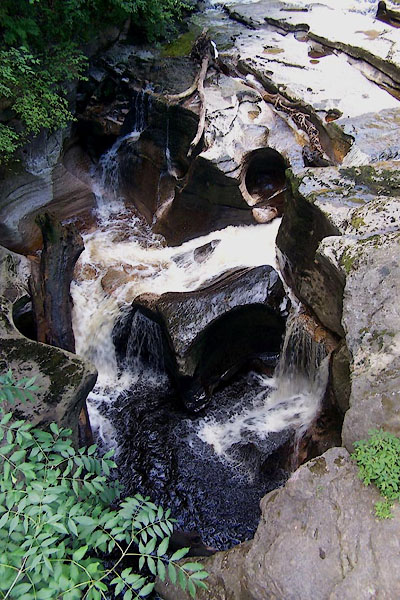
BNX64.jpg (taken 8.8.2007)
placename:- Cowkurnal Hole
item:- giant's pot; church pot
 goto source
goto sourcePennant's Tour 1773, page 134 "... it forms a lofty cataract, and rushes over a most rugged channel, shagged with trees - a most picturesque scene! Below the bridge is a bason of water fourteen feet deep. In the low state in which I saw it, the waters pass through so narrow a gap in the stone that I spanned the top with my hand, but just beneath it has worn the channel to a great width. Above the bridge the rock is hollowed into multitudes of circular holes, from one foot to six in diameter, and from the depth of six inches to that of two yards, according to the space in which they have been formed. The channel is quite honey-combed"
 goto source
goto sourcePennant's Tour 1773, page 135 "with these giant's pots, as they are called in Sweden. - They certainly are not Druidical, as some have conjectured, but owe their formation to the vortiginous fury of floods, which whirls about the pebbles or gravel with such force as to bore, I may say, these singular cavities."
item:- lava; volcano
 goto source
goto sourceGentleman's Magazine 1799 p.643 "... Upon stopping at Kirkby Stephen, to refresh ourselves, we enquired of the landlord of the inn if there was any thing in the place or its neighbourhood deserving the attention of strangers. Our host, who was rather a sensible fellow, told us that there was this natural curiosity at Stankthred Bridge, which was about half a mile from his house, and which some few solitary travellers had occasionally visited. We were accordingly soon furnished with a guide to the spot; and such was our impatience, that we reached it in a few minutes."
"This phaenomenon consists of the bed of a river, formed entirely of rocks, of different strata of white stone, rather level on their surface, as if worn with water. The stream, which in Summer is very slender and small, runs from North to South, not over this bed of rocks, but through a passage or fissure in the middle of it, from about a foot to a yard wide in different places, but extending in depth to the bottom of the rocks. In Winter, when the torrents descend from the mountains, their surfaces are of course quite overflowed. I was much pleased with tracing the course of the stream as it rushed along its narrow channel. It was, in some places, ten or fiftenn feet below the surface of the rock; and, at other places, was obliged to spread itself, in order to find a passage, thence descending in fine cascades, one of which, near the bridge, descended a perpendicular height of near twenty feet into a large basin formed in the rock, with great noise and grandeur. These waterfalls proceed not only from the different number of strata in different parts of the bed of the river, but are likewise, in a great degree, occasioned by the nature of the country, which is uncommonly mountainous, a high ridge of mountains running all along the Southern boundary of Westmorland, down which rush several streams in different places, and this one amongst the rest. I walked along the bed of this river over the tops of these rocks, and they seemed to me (judging form the fissure along which the water ran) to be about thirty of forty feet thick. The breadth of this bed of stone was nearly the same, and extended in length about a quarter of a mile. If this sort of appearance presented itself in Italy instead of England, no naturalist would hesitate a moment to determine it the effect of some volcanic eruption. It has every feature which marks the character of a torrent of lava, rushing into the bed of a river, and filling up the space it occupied. It is also extraordinary to accunt for the manner in which the stream has worked its passage through this bed of intruding lava, particularly as the distance is so great; to effect which, there is no doubt that it must have required many ages. For my own part, when I combine the appearance of this bed of lava with the shape of the mountain which overlooks Stankthred Bridge and the town of Kirby Stephen, I have no doubt that it is the eruption of some volcano, and that the mountain, instead of discharging a stream of water as at present, has formerly poured from its bosom a torrent of liquid fire, the remains of which are now seen. This will not appear so extraordinary, when we consider that it has long been a fact ascertained by naturalists, that calcined rocks, pumice-stone, and lava, the undoubted vestiges of volcanos, are not peculiar to any country or climate. They have been discovered in France, Germany, the West Indies, and the islands in the South Seas. There are even as many proofs of the existence of extinguished"
 goto source
goto sourceGentleman's Magazine 1799 p.644 "eruptions in this island. It is well known that in the strata of Darley Moor, in Derbyshire, there is both lime-stone and lava; in the former of which Mr. Moor of Bakewell, lately discovered the remains of a petrified crocodile. Many other instances might also be adduced; but I have never heard of or seen any thing of this kind so perfect in its shape, and so peculiarly possessing the features of the Sicilian torrent of lava, as the place I have been describing. If any of your readers can give me a satisfactory explanation of this phaenomenon, I shall be much obliged to them. At present I cannot forbear adding it to the list of those examples of the disordered face of Nature, which go strongly to prove an unbounded succession of events, and unceasing revolutions of Nature, through invulnerable ages and an eternity of time."
"Yours &c."
"G. COOPER."
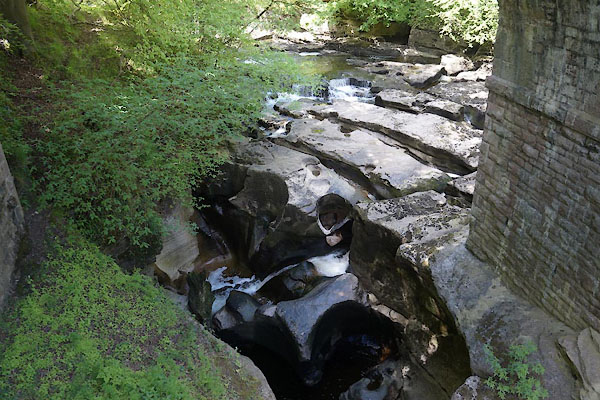
CDC56.jpg (taken 26.5.2015)
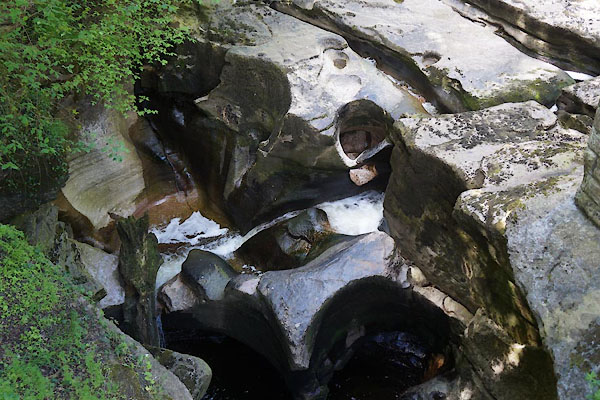
CDC57.jpg (taken 26.5.2015)
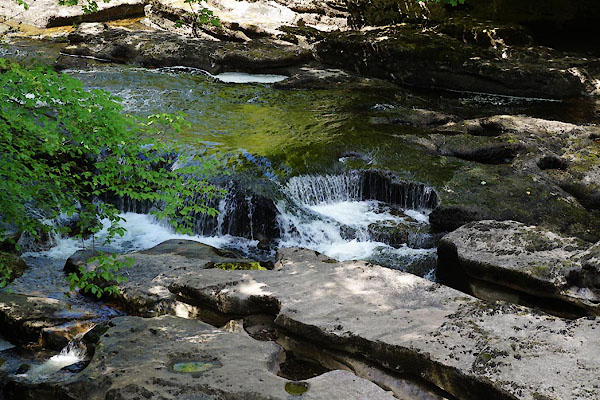
CDC58.jpg (taken 26.5.2015)
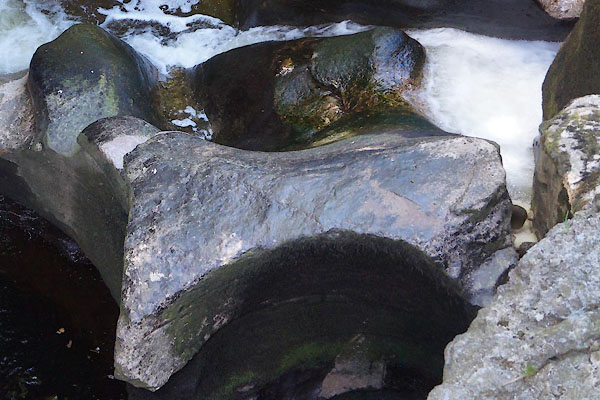
CDC59.jpg (taken 26.5.2015)
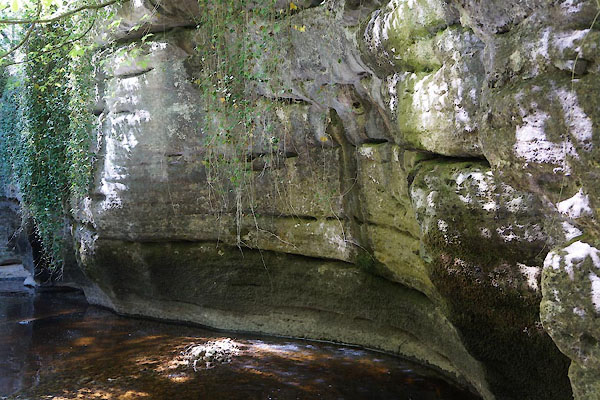
CDC60.jpg (taken 26.5.2015)
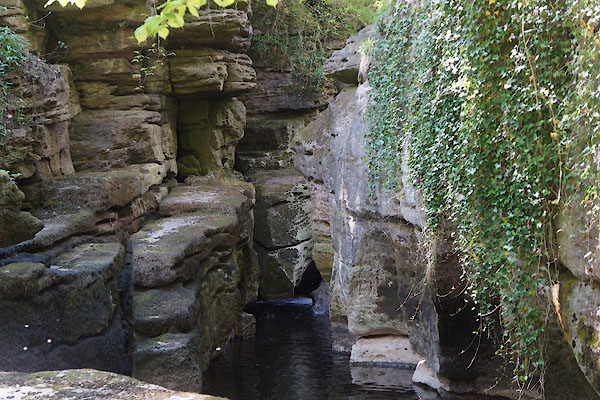
CDC61.jpg (taken 26.5.2015)
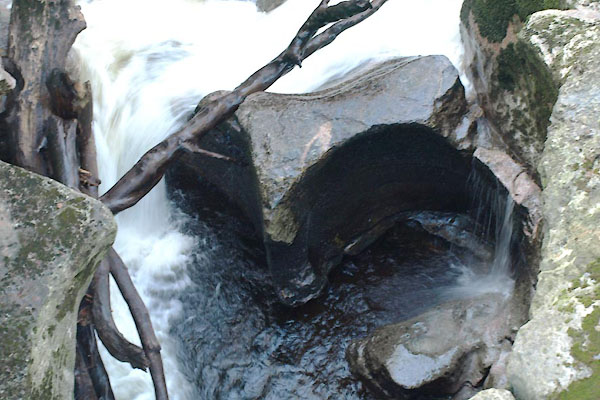
BVU56.jpg (taken 13.1.2012)
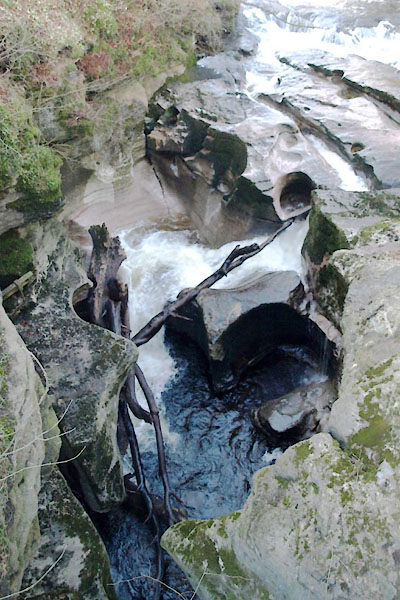
BVU55.jpg (taken 13.1.2012)
